Mezen painting – Ancients ornaments that reached our days
The Mezen painting (Ме́зенская ро́спись) is one of the most ancient Russian art crafts. Using this technique, Russian folk artists decorated most of the household items that accompanied a person from birth through its entire life, where it brought joy and beauty. It also occupied a large space in the design of facades and of hut interiors.
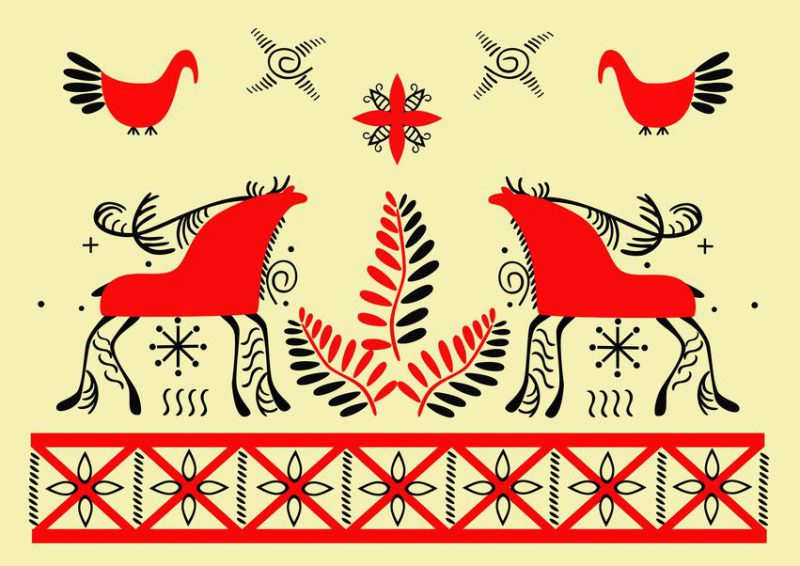
Like most other folk crafts, the Mezen painting got its name from the area in which it originated. The Mezen River is located in the Arkhangelsk Region, on the border with the taiga and tundra. By the beginning of the twentieth century, the village of Palaschel’ye (Палащелье) located on the river Mezen had become the center of the Mezen painting on wood. Therefore, this specific type of painting also called Palaschelskaya (Палащельская).
The most ancient artefacts picturing Mezen patterns – painted spinning wheel – dates back to 1815. But it only became widespread in the 19th century.
Subjects in painting
The Mezen painting has its own distinctive ornaments. Despite its apparent simplicity, it attracts and fascinates, while the objects painted in Mezen patterns look like they are glowing from the inside and exude the good and wisdom of our ancestors.
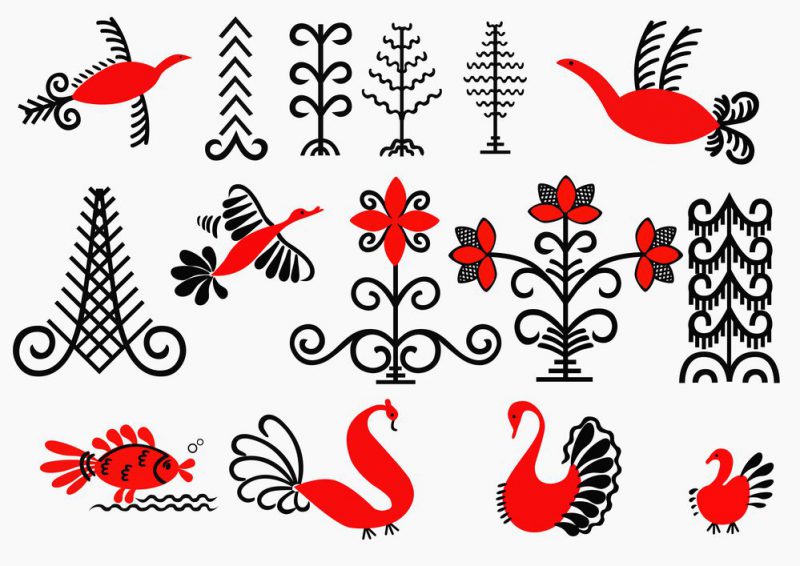
Every single detail of the ornament on Mezen paintings is deeply symbolic. Each square and diamond, leaf and twig, beast and bird are located at the exact place where they should be to tell us the story of the forest, the wind, the earth and the sky, as well as the artist’s thoughts and ancient images of the northern Slavs.
The origins of the symbols in Mezen paintings primarily lie in the mythological worldview of the peoples from the ancient North. For example, the frequent multiple layers follow the shamanic traditions: the three layers represent three worlds (lower, middle and upper). In Mezen paintings, the lower and middle layers are filled with deers and horses, and the upper layer with birds.
The characters were painted in the two traditional colors of Palaschelskaya painting – red and black.
Red horses personified the sun. Several horses, depicted one after another, indicated the movement of the sun in the sky.
Geese, swans and ducks were considered the souls of departed relatives flying close to the living and coming to help in difficult times.
Family life trees were drawn with a trunk filled with rhombuses – numerous kinds of ancestors. The tree’s curled roots symbolized the underworld and the solar sign on the top was a symbol of the heavens.
No painting is made without all sorts of waves, zigzags and spiral shapes. Numerous short strokes scattered all over the ornament or next to the main characters most likely represent air or wind – one of the primary elements of nature.
The wavy lines of the water element accompany all the straight lines of the ornaments and waterfowls.
Everything that resembles a circle (like spirals) remind us of the sun (fire). The spiral also carries other symbolic meanings. Spiral forms are very often found in nature, ranging from galaxies to whirlpools and tornadoes, from the shells of mollusks to drawings on human fingers. The compressed spiral spring is a symbol of latent power, a tangle of energy. The spiral, which combines the form of a circle and a movement impulse, is also a symbol of time, cyclical rhythms of the year’s seasons. Double spirals symbolize the balance of opposites and harmony (as the Taoist sign of “yin-yang”). The ascending spiral is a male sign, the descending one is female, which makes the double helix also a symbol of fertility and childbirth.
It should be noted that ancient signs of fertility were very popular in folk crafts and could be placed everywhere. If it was put on a plate that covers a keyhole of a granary, it meant the wish for the granary to always be full. If a sign of abundance was depicted at the bottom of a spoon, it meant the wish of never coming hunger. If they were placed on the hem of wedding shirts, they symbolized the wish for the couple to have a big and full family. Almost all of the Mezen ornaments are somehow connected with the theme of fertility and abundance. Plowed fields, seeds, roots, flowers and fruits are depicted in a variety of fashions and are very diverse.
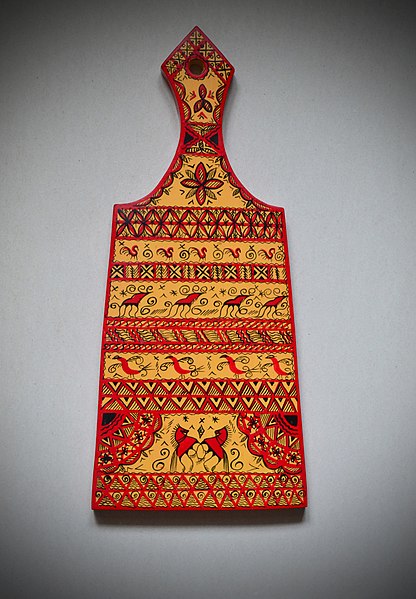
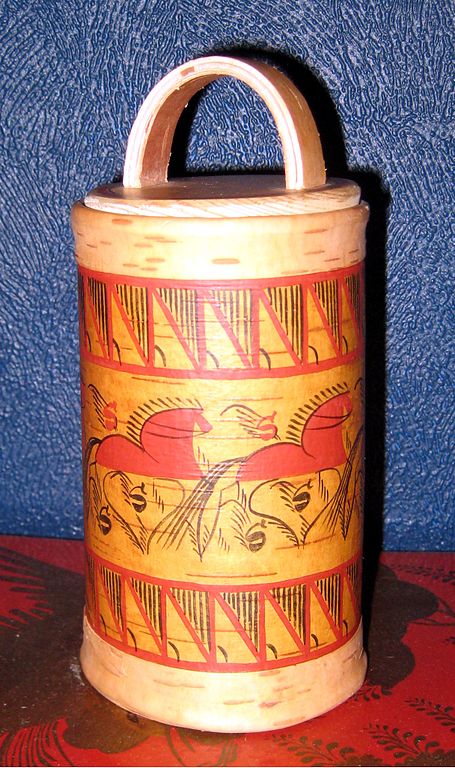
Technology of production and the objects
Traditionally, the objects painted in Mezen patterns have only two colors – red and black. Black color was obtained from a mixture of carbon black with a solution of larch resin, whereas red paint was made from clay found on the shore, and later on from red lead.
The painting was applied on a non-primed tree with a special wooden stick, a feather of wood grouse or black grouse, or with a brush made of human hair. To achieve the bright yellow shade, the product was covered with oil varnish, and it was soaked in linseed oil to achieve softness.
These days, the technology and techniques of Mezen painting have been preserved with the exception that brushes are used more often now.
According to tradition, only men were engaged in Mezen painting, and the craft was passed down from generation to generation. At first, beginners were told about the symbols and how to combine in a pattern, and then taught to draw contours. Before drawing the ornament, future craftsmen practiced for a long time making rods and lines.
Most often, the craftsmen covered with ornament spinning-wheels, boxes, and bread baskets. Spinning wheels were made mostly of spruce or birch. In ancient times, birch wood was considered more expensive as it has a more uniform base and, therefore, higher strength. Spruce wood differed by a lighter color and the smell of its needles.
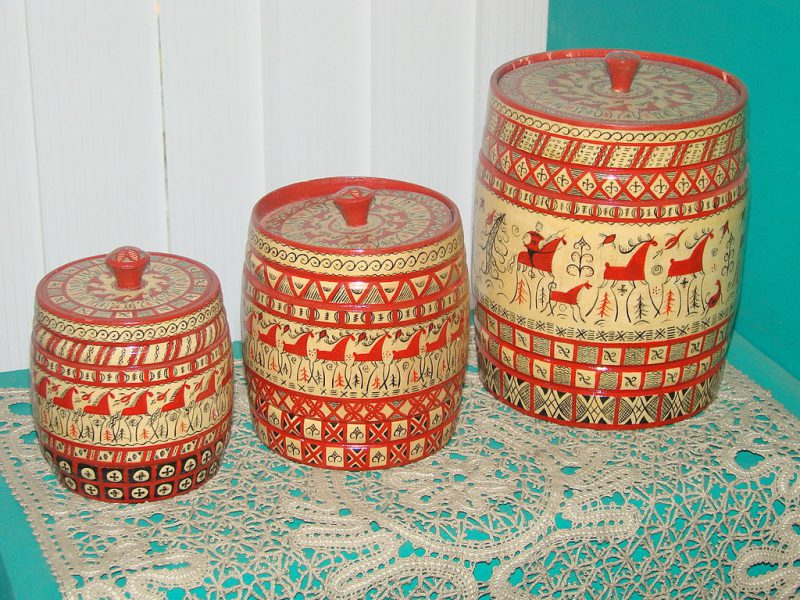
Mezen painting in our days
Nowadays, Mezen paintings are widely used in Severodvinsk and Arkhangelsk on souvenir products of the “Belomorskyе Uzory” experimental enterprise. Today, however, mainly women are engaged in painting. Modern drawings are applied with a brush and have a more streamlined shape compared with the paintings of the old days. The sketchiness and simplicity of patterns make the painted objects well perceived by the public.







Excellent analyses!